English Springer Spaniel
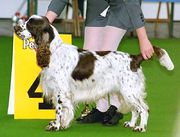 |
|||||||||||||||||||||||||
| English Springer Spaniel | |||||||||||||||||||||||||
| Other names | Springer Spaniel | ||||||||||||||||||||||||
|---|---|---|---|---|---|---|---|---|---|---|---|---|---|---|---|---|---|---|---|---|---|---|---|---|---|
| Country of origin | England | ||||||||||||||||||||||||
|
|||||||||||||||||||||||||
|
|||||||||||||||||||||||||
| Dog (Canis lupus familiaris) | |||||||||||||||||||||||||
The English Springer Spaniel is a breed of gun dog traditionally used for flushing and retrieving game. It is an affectionate, excitable breed with an average lifespan of twelve to fourteen years.[1] Descended from the Norfolk or Shropshire Spaniels of the mid 1800s, the breed has diverged into separate show and working lines. The breed suffers from average health complaints. The show-bred version of the breed has been linked to "rage syndrome," although the disorder is very rare. It is closely related to the Welsh Springer Spaniel and very closely with the English Cocker Spaniel, in fact less than a century ago, springers and cockers would come from the same litter. They are commonly used as sniffer dogs by various nations. The term springer comes from their historic hunting role, where the dogs would "spring" or "flush" birds into the air.
Contents |
Description
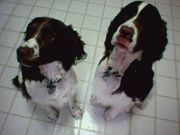
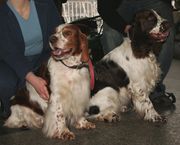
The English Springer Spaniel is a medium sized compact dog. Its coat is moderately long with feathering on the legs and tail. It is a well proportioned, balanced dog with a gentle expression and a friendly wagging tail.[2] This breed represents perhaps the greatest divergence between working and show lines of any breed of dog. A field-bred dog and a show-bred dog appear to be different breeds, but are registered together. In fact, the gene pools are almost completely segregated and have been for at least 70 years.[3] A field-bred dog would not be even remotely competitive in a modern dog show while a show dog would be unlikely to have the speed or stamina to succeed in a field trial.[4]
Field-bred dogs tend to have shorter, coarser coats than the show-bred dogs. Their ears are less pendulous. Field-bred dogs are wiry and have more of a feral look than those bred for showing. The tail of the field-bred dog is only docked by a few inches in comparison to the show dog to provide a "flag" for the hunter. Docking also prevents laceration of the tail during hunting. Field-bred dogs are generally selected for nose, hunting ability, and response to training rather than appearance.[4]
Show dogs have longer fur and more pendant ears, dewlaps and dangling flews. The tail is docked to a short stub in those countries that permit docking. They are generally more thickly boned and heavier than field-bred springers.[4]
The English Springer Spaniel is similar to the English Cocker Spaniel and at first glance the only major difference is the latter's smaller size. However English Springers also tend to have shorter, and higher-set ears than English Cockers. In addition Springers also tend to have a longer muzzle, their eyes are not as prominent and the coat is less abundant.[5] The major differences between the Welsh Springer and the English Springer is that the Welsh have more limited colours and tend to be slightly smaller.
Coat & Colours
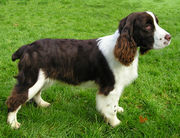
Field-bred dogs tend to have shorter, coarser coats than the longer furred show-bred dogs. They normally only shed in summer and spring months, but shed occasionally in the autumn.[3] The coat comes in black or liver (dark brown) with white markings or predominantly white with black or liver markings; Blue or liver roan; Tricolour: black and white or liver and white with tan markings, usually found on eyebrows, cheeks, inside of ears and under the tail. Any white portion of the coat may be flecked with ticking.
Sizes
Males in the show dog line average approximately 18 to 20 inches (46 to 51 cm) at the withers and weigh on average 50 to 55 lb (23 to 25 kg). According to the UK (FCI) Breed Standard, the English Springer Spaniel should be 20 inches (51 cm) at the withers. The females should be 17 to 19 inches (43 to 48 cm) and usually 35 to 45 lb (16 to 20 kg). Working types can be lighter in weight and finer in bone.
Temperament
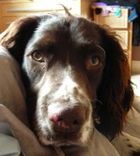
The typical Springer is friendly, eager to please, quick to learn and willing to obey.[6] An affectionate and easy-going family dog, its alertness and attentiveness make it the ideal hunting companion. The English Springer Spaniel ranks 13th in Stanley Coren's The Intelligence of Dogs, considered an excellent working dog. It has exceptional stamina and needs moderate amounts of activity, to focus its mind and to provide exercise, although this is different for each dog. English Springers need plenty of exercise in order to run off their excess energy. Its long-legged build makes it among the fastest of the spaniels.
It is a sociable breed that enjoys the company of children and handles the company of other pets well, except birds, however they can become aggressive to other dogs of the same sex. If left alone for too long, they can become destructive and mischievous through boredom. They love the water, and tend to get wet whenever they have the chance.[7]
Rage syndrome
They are one of the breeds in which rage syndrome has been recognised.[8] It is normally reported in Cocker Spaniels, however due to the Springer's relatively recent ancestry with that breed, it is also affected. It is described as when a dog attacks suddenly, often with a glazed look and appearing to be unaware of its surroundings.[9] It can last from a few seconds to a few minutes, with the dog immediately returning to normal afterwards.[10] There is no clear theory as to the source of rage syndrome, and treatment that works on one dog may not work on another. Cases are very rare and research is ongoing.[11] It is only the show bred lines that seem to be affected, as there has been no reported cases in pure field-bred lines.[12]
Health
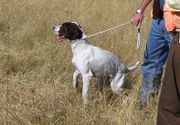
As in most breeds, there are some health problems that are more likely to occur in this breed. Hip dysplasia, a malformation of the hip joints that leads to arthritis, and progressive retinal atrophy (PRA) which is a degeneration of the retina causing vision loss leading to blindness, are two such diseases for which veterinarians are working on genetic markers to determine carriers. Another problem can be elbow dysplasia. [8] Retinal dysplasia (RD) which can cause blindness and Phosphofructokinase deficiency (PFK) which is genetic deficiency which impairs the ability of cells using carbohydrates for energy are two other hereditary conditions that both lines of the English springer spaniel should be screened for prior to breeding.[13] Health issues are usually similar in both types of English Springer however phosphofructokinase deficiency in particular can appear more in field lines, however carriers in show lines have been identified.[14]
As with most spaniels and floppy eared dogs, they are prone to ear infections. Treatment can including cleaning the ear canal weekly with a solution that will leave the ear in an acidic state to retard the growth of yeast and bacteria.[15]
Other health problems include autoimmune diseases, which include allergies and other sensitivities to the environment.[16] They can also be susceptible to various eye problems including inward or outward curling eyelashes or even an additional row of eyelashes, all of which can require corrective surgery.[17]
They tend to gain weight easily, and owners need to be careful about their food consumption.[1]
Skills
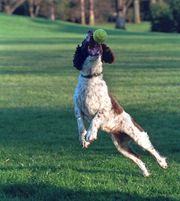
An English Springer Spaniel is first and foremost an upland flushing dog. There are a number of skills that breeders train the dog to perform for their occupation.[18]
- Retrieve to Hand Most hunters and all hunt test or field trial judges require that a dog deliver a bird to hand, meaning that a dog will hold the bird until told to give it to the hunter directly.
- Soft Mouth Springers are taught to deliver game with a soft mouth, meaning he does not puncture it with his teeth. The game should always be fit for the table. If a springer damages the bird, it may be hard mouthed. This is a serious fault, but it can be difficult to determine whether it may have been genetic or caused by poor training methods. Breeders generally avoid using any springer that is hard mouthed.
- Quarter A flushing spaniel's primary role is often as an upland flushing dog. Dogs must work in a zig-zag pattern in front of the hunter seeking upland game birds. The dog is taught to stay within gun range to avoid flushing a bird outside of shooting distance. This pattern is one of the primary criteria used to judge a dog in a field trial.
- Scenting Having the ability to scent game is of vital importance to the hunter. A springer should have a good nose in both wet and dry conditions. A dog with a good nose will learn to use the wind as it quests for game, ever adjusting its pattern according to the nuances of the wind.
- Flushing The springer should have a positive flush. It should not hesitate or point when encountering game. Some field trial dogs will often get airborne during a flush. This is exciting to watch, but is not necessary to win. Most hunters prefer that their dog not flush in that style, as it can present a risk to the dog.
- Hup This is the traditional command to sit and stay. When hupped the dog can be given direction called to the handler. The ability to hup a dog actively working a running bird allow the handler and any gunners to keep up without having to run.
- Follow Hand Signals Upland hunting involves pursuing wild game in its native habitat. Gun dogs must investigate likely covers for upland game birds. The dog must be responsive to hand signals in order for the hunter to be able to direct the dog into areas of particular interest.
- Steady When hunting upland birds, a flushing dog should be steady to wing and shot, meaning that he sits when a bird rises or a gun is fired. He does this in order to mark the fall and to avoid flushing other birds when pursuing a missed bird.
- Blind Retrieve An adequately trained and experienced working springer can be expected to use all of the aforementioned attributes to be conducted by hand, whistle and command to a position whereby an unmarked lost game bird can be picked and retrieved to hand.
History
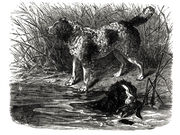
English physician Dr. John Caius described the spaniel in his book the Treatise of Englishe Dogs published in 1576. His book was the first work to describe the various British breeds by function.[19] By 1801, Sydenham Edwards explained in the Cynographia Britannica that the land spaniel should be split into two kinds, the Springing, Hawking Spaniel, or Starter, and the Cocking or Cocker Spaniel.[19]
At this point in time, both cocker spaniels and springer spaniels were born in the same litters. The purpose of the breed was to serve as a hunting dog. The smaller cockers were used to hunt woodcock, while their larger littermates, the springer spaniels, would "spring"—or flush—the gamebird into the air where a trained falcon or hawk would bring it to the handler.[2]
Many spaniel breeds were developed during the 19th century, and often named after the counties in which they were developed, or after their owners, who were usually nobility. Two strains of larger land spaniel were predominant and were said to have been of "true springer type." These were the Norfolk and the Shropshire spaniels, and by the 1850s, these were shown under the breed name of Norfolk spaniel.[20]
In January 1899, the Spaniel Club of England and the Sporting Spaniel Society held their trials together for the first time. Two years later, in 1902, a combination of the physical standard from the Spaniel Club of England and the ability standard from the Sporting Spaniel Society led to the English Springer Spaniel breed being officially recognised by the English Kennel Club. The American Kennel Club followed in 1910.[20] In 1914, the first English Field Champion was crowned, FTC Rivington Sam, whose dam was a registered cocker spaniel, Rivington Riband. Sam is considered one of the foundation sires for modern field lines.[20]
Use as sniffer dogs
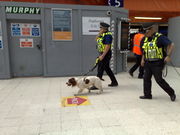
Springer Spaniels are commonly used as sniffer dogs for a variety of tasks and by a variety of nations. Notable cases of explosive search dogs have included Buster, a Dickin Medal recipient, Royal Army Veterinary Corps arms and explosives search dog serving with the Duke of Wellington's Regiment in Iraq, for finding an extremist group's hidden arsenal of weapons and explosives.[21] Another example is Jake, aka Hubble Keck People's Dispensary for Sick Animals Gold Medal and Blue Cross Animal Hospital Medal recipient, a London Metropolitan Police explosives search dog. He was deployed at Tavistock Square, Russell Square and King's Cross following the 7 July 2005 London Bombings.[22]
However the Springer's nose is not limited to just explosives, they can also be used for much more precise work. Murphy, a male Springer has been trained by HM Prison Service in HMP Norwich to search for mobile phones. His nose is so precise that he can even tell the difference between the guard's phones and any illegal phones held by inmates.[23] Other varied uses for the Springer's nose can include sniffing out bumblebee nests,[24] illegal immigrants,[25] and blood.[26]
Springers are used as drug dogs by agencies in a variety of nations including Sweden,[27] Finland,[28] UK,[29] Isle of Man,[30], and Qatar.[31]
There are fears that their usage as drug sniffer dogs could lead to rare forms of nose cancer. A nine year old male Springer named Max died of an aggressive tumour in his nose, a rare health problem in dogs. His vet suggested that his police work as a drug dog may have caused his death.[32]
Notable English Springer Spaniels
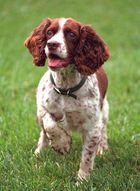
Bench (Show) Champions
- Ch. Felicity's Diamond Jim (James), 2007 Westminster Kennel Club Best in Show[33] and 2006–2007 AKC National Championship Best in Show[34]
- Ch. Salilyn-N-Erin's Shameless (Samantha), 2000 Westminster Kennel Club Best in Show[33]
- Ch. Salilyn's Condor (Robert), 1993 Westminster Kennel Club Best in Show[33]
- Ch. Chinoe's Adamant James, 1971 & 1972 Westminster Kennel Club Best in Show[33]
- Ch. Wakefield's Black Knight, 1963 Westminster Kennel Club Best in Show[33]
Field Champions
- 2006 National Field Champion, 2007 2nd US High Point Open, Certificate of Merit US National Amateur, 2008 2nd Canadian National Championship - NFC/FC/CFC/AFC Crosswinds Warpath (Zip) - Owners Kevin/Betsey Battistoni Handlers - Jim Keller/Kevin Battistoni[35]
- 2005 NFC FC AFC BJ's Dan of Danville, US National Open ESS Field Champion, owner Doug Miller, trained by Doug Miller and Dan Langhans[36]
- 1987 NFC FC Pondview's Left in the Light, US National Open ESS Field Champion, breeder and owner: Ray Cacchio[37]
- 1980 NFC 1980 NAFC 1979 & 1980 CNFC Saighton's Scud, only winner ever of all three North American national field trial championships, breeder: Mr. Talbot Radcliffe, owners: Drs. Chris & Janet Christensen[38]
- 1973 & 1975 NFC AFC CFC Dewfield Bricksclose Flint, two time US National Open ESS Field Champion, breeder: Jim Locke, owners: Drs. Chris & Janet Christensen[39]
- F.T.Ch. Saighton's Stinger, 1965 English National Field Trial Champion, Mr. Talbot Radcliffe[40]
Presidential pets
Springers have been in the White House twice in recent years, both in the Bush family. Former US President George H. W. Bush had a female Springer named Millie, who in turn was the mother of George W. Bush's dog Spot.
See also
- English Cocker Spaniel
- Welsh Springer Spaniel
- Hunting dog
- Sporting Group
References
- ↑ 1.0 1.1 Burke, Don. The complete Burke's backyard: the ultimate book of fact sheets. Barron's Educational Series. p. 789. ISBN 740457390.
- ↑ 2.0 2.1 "AKC MEET THE BREEDS: English Springer Spaniel". American Kennel Club. http://www.akc.org/breeds/english_springer_spaniel/. Retrieved 17 February 2009.
- ↑ 3.0 3.1 "Know The Difference Between A Show Bred & Field Bred English Springer Spaniel". English Springer Spaniel Information and Field Trial Page. http://www.essft.com/fieldshow.html#FIELD. Retrieved 9 July 2007.
- ↑ 4.0 4.1 4.2 "English Springer spaniel". SpringerSpaniel.org.uk. http://www.springerspaniel.org.uk/english_springer_spaniel.htm. Retrieved 25 October 2009.
- ↑ Gormish, Denise. "A comparison of English Springer Spaniels, American Cocker Spaniels and English Springer Spaniels". English Cocker Spaniel Club of America. http://www.ecsca.org/difference.html. Retrieved 13 September 2009.
- ↑ "English Springer Spaniel Field Trial Association Main Page". English Springer Spaniel Field Trial Association. http://essfta.org/. Retrieved 9 July 2007.
- ↑ "English Springer Spaniel Breed". 5StarDog. http://www.5stardog.com/dog-breeds-english-springer-spaniel.asp. Retrieved 2009-11-09.
- ↑ 8.0 8.1 Ditto, Tanya B. (26 May 2000). English Springer Spaniels: A Complete Pet Owner's Manual. Barron's Educational Series. ISBN 0812017781.
- ↑ Ward, Linda (2002). "Rage Syndrome in Cocker Spaniels". Dogstuff.info. http://www.dogstuff.info/cocker_rage_syndrome.html. Retrieved 24 October 2009.
- ↑ DeLahunta, Alexander. Veterinary Neuroanatomy and Clinical Neurology (3rd Revised ed.). Elsevier Health Sciences. p. 452. ISBN 9780721667065.
- ↑ "What is Rage Syndrome". Rage Syndrome Information Centre. http://members.lycos.co.uk/ragesyndromeinfo/whatisrage.htm. Retrieved 25 October 2009.
- ↑ Derr, Mark (April 2004) (in English). Dog's best friend: annals of the dog-human relationship (Paperback ed.). University Of Chicago Press. p. 138. ISBN 0226142809.
- ↑ "Phosphofructokinase Deficiency in the English Springer Spaniel". English Springer Spaniel Field Trial Association. http://www.essfta.org/Health_Research/pfk.htm. Retrieved 08 November 2009.
- ↑ Bell, Jerold S. (1998-02-28). "The Proper Use of Genetic Tests in Spaniel Breeding Decisions". Spaniels in the Field. http://www.spanielsinthefield.com/spaniel-health-05.asp. Retrieved 2009-11-09.
- ↑ "Ear Infections in Dogs:A Complete Guide To Dog Ear Infections". EarInfectioninDogs.com. 2008. http://www.earinfectionindogs.com. Retrieved 08 November 2009.
- ↑ "English Springer Spaniel Health". Ariel English Springer Spaniels. http://www.ariel-ess.com/essfaq/health.html. Retrieved 08 November 2009.
- ↑ Alderton, David (2006). Top to Tail:The 360 Degrees Guide to Picking Your Perfect Pet. David & Charles PLC. p. 110. ISBN 0715325892.
- ↑ "English Springer Spaniel - Key Field Skills". Petwave.com. http://www.petwave.com/Dogs/Dog-Breed-Center/Sporting-Group/English-Springer-Spaniel/Field-Skills.aspx. Retrieved 25 October 2009.
- ↑ 19.0 19.1 Mymudes, Mindy (3 March 2002). "An English Springer History". http://www.ariel-ess.com/essfaq/history.html. Retrieved 24 October 2009.
- ↑ 20.0 20.1 20.2 "The History of the Springer Spaniel". http://www.westwingsess.com/ESS_History.htm. Retrieved 24 October 2009.
- ↑ "PDSA Dickin Medal: 'the animals' VC'". PDSA.org.uk. Archived from the original on April 17, 2008. http://web.archive.org/web/20080417001934/http://www.pdsa.org.uk/page309_2.html. Retrieved 2009-11-09.
- ↑ "Police dog Jake is awarded". Met.Police.UK. 2007-01-10. http://cms.met.police.uk/news/policy_organisational_news_and_general_information/police_dog_jake_is_awarded. Retrieved 2009-11-09.
- ↑ Kay, John (2007-01-11). "Jail dog finds smellphones". TheSun.co.uk. http://www.thesun.co.uk/sol/homepage/news/article7644.ece. Retrieved 2009-11-09.
- ↑ "Toby the bumblebee sniffer dog". Bumblebee Conservation Trust. http://www.bumblebeeconservation.org.uk/toby.htm. Retrieved 2009-11-09.
- ↑ "Agency sniffer dog finds illegal immigrants attempting to smuggle themselves into the UK". UK Borders Agency. 2009-02-02. http://www.ukba.homeoffice.gov.uk/sitecontent/newsarticles/sniffer-dog-finds-illegals?area=NorthEastYorkshireandHumber. Retrieved 2009-11-09.
- ↑ McVeigh, Karen (2005-12-30). "On scent of success: sniffer dog Keela earns more than her Chief Constable". Times Online. http://www.timesonline.co.uk/tol/news/uk/article783458.ece. Retrieved 2009-11-09.
- ↑ "Drug detector dogs". Swedish Customs Service. http://www.tullverket.se/en/startpage/aboutswedishcustoms/drugdetectordogs.4.6edda07011f9252a5a98000653.html. Retrieved 2009-11-09.
- ↑ "Drug detector dogs of Finnish Customs". Tulli Customs. http://www.tulli.fi/en/finnish_customs/publications/brochures/general/Drug_detector_dogs_08.pdf. Retrieved 2009-11-09.
- ↑ "About our dogs". North Yorkshire Police. http://www.northyorkshire.police.uk/index.aspx?articleid=2460. Retrieved 2009-11-09.
- ↑ "Dogs and Handlers". Isle of Man: Department of Home Affairs. http://www.gov.im/dha/prison/dogs.xml. Retrieved 2009-11-09.
- ↑ Senger, Dustin (2009-04-13). "Qatar Military Dog Show Enhances Bilateral Relations". dvidshub.net. http://www.dvidshub.net/?script=news/news_show.php&id=32367. Retrieved 2009-11-09.
- ↑ "Police sniffer dog dies of nose cancer after sniffing cocaine". Telegraph.co.uk. 2009-01-27. http://www.telegraph.co.uk/news/newstopics/howaboutthat/4357551/Police-sniffer-dog-dies-of-nose-cancer-after-sniffing-cocaine.html. Retrieved 2009-11-09.
- ↑ 33.0 33.1 33.2 33.3 33.4 "Best In Show Winners". http://www.westminsterkennelclub.org/history/biswinners.html. Retrieved 26 April 2009.
- ↑ "Meet James". Animal Planet. http://animal.discovery.com/convergence/eukanuba/akcchampionship/past/champs/james/james.html. Retrieved 26 April 2009.
- ↑ Battistoni, Kevin. "Mysterious Illness Strikes NFC FC AFC CFC Crosswinds Warpath "Zip"". Spaniel Journel. http://www.spanieljournal.com/kbattistoni.html. Retrieved 24 October 2009.
- ↑ "2006 National Open Championship Information". National English Springer Spaniel Field Trial Association. http://essft.com/2006noc/06noc_index.htm. Retrieved 24 October 2009.
- ↑ Baughan, Loretta. "1987 NFC/FC Pondsviews Left in the Light". Spaniel Journel. http://www.spanieljournal.com/17lbaughan.html. Retrieved 24 October 2009.
- ↑ DeMott, John. "Memories of Scud, His Littermates, and Associated Stories (part 2) Page 4". Spaniel Journel. http://www.spanieljournal.com/3jdemott4.html. Retrieved 25 October 2009.
- ↑ Christensen, Janet. "NFC, AFC, CFC Dewfield Bricksclose Flint". Spaniel Journel. http://www.spanieljournal.com/jchristensen.html. Retrieved 25 October 2009.
- ↑ McCurdy, David. "Talbot Radcliffe". Spaniels in the Field. http://www.spanielsinthefield.com/library-09.asp. Retrieved 25 October 2009.
External links
- English Springer Spaniel at the Open Directory Project
- English Springer Spaniel Field Trial Association
|
|||||||||||
|
|||||||||||||||||